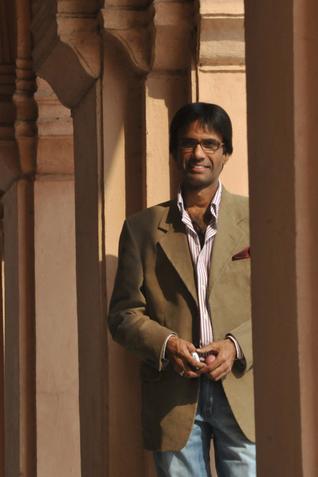Hyderabad, TELANGANA (formerly ANDHRA PRADESH ) :

The Wahabi Conspiracy of prince Mubarez-ud-Daulah is a forgotten chapter in Hyderabad history
While the attack of Turrebaz Khan on the British Residency in Hyderabad during the 1857 Revolt is well documented in the pages of Hyderabad’s history, a similar bold revolt planned to overthrow the British by Prince Mubarez-ud-Daulah, the younger brother of the Nizam, though foiled in the last moment, is hardly remembered.
The Wahabi conspiracy in Hyderabad was a serious secret movement aimed against the English around 1838. Prince Mubarez-ud-Daulah had the support of Rasool Khan, the Nawab of Kurnool, who like Mubarez also hated the presence of the British. But as ill-luck would have it, before they could strike, the British were able to unearth the conspiracy through their intelligence agencies and the entire plans, went awry. Mubarez was imprisoned till death and Rasool Khan was captured, exiled and his territory, confiscated. However, the well-planned attempt they made served as an inspiration at a time when the very idea to oppose the British authority was in a nascent stage in these parts of the country.
Wahabi Movement was a 17th century reform movement that began in Persia with a view to see the basic tenets of Islam were followed strictly and with sincerity. The movement was started by one Wahab in the 18th century and therefore it was named after him. Wahabi movement was popularised in India by the Islamic religious leader, Shahwaliullah. Wahabis opposed the British presence in India and their slogan was: “Jan ko denge- vathan ko bachayenge” (Let us sacrifice our lives; but safeguard our motherland”).
Role of Mubarez-ud-Doulah
Mubarez–ud–Doulah, the Hyderabadi prince was one of the first in south India to come under the influence of the Wahabi movement. Mubarez, born in 1800, was the second son of Sikander Jah, the Nizam of Hyderabad (1803-1829). As Mubarez had greater access to wealth and also had a private army of more than a lakh, he could devote all his time and resources for the Wahabi movement in Deccan.
From his childhood, Mubarez disliked the presence of the British in Hyderabad. As a result he was imprisoned for nearly five years from 1815 by his father, Sikander Jah at the behest of the British. Mubarez was incarcerated once again, this time during the period of his brother, Nasir-ud-Doulah (1829-57). In 1830, Mubarez collected a large army of Arabs and Afghans and started an insurrection against the British. Then a contingent of British troops under Col. Stewart marched against Mubarez and arrested him. The prince was sent to the fort of Golconda and imprisoned for several months in 1830.
The hatred of Mubarez-ud-Daulah towards the British, even as an young boy was such that once his father Sikandar Jah wanted a British sentry to be posted as a guard at his palace. But the young Prince replied that he would prefer to die rather than to see a British guard at his palace gate.
Alliance with Nawab of Kurnool
Rasool Khan the Nawab of Kurnool too was attracted towards the Wahabi movement. When Mubarez came to know of Rasool Khan’s opposition to the British, he sent his men to strike a secret alliance with the Nawab of Kurnool. Rasool Khan agreed to establish a secret arsenal to manufacture arms and ammunition that was needed for any concerted insurrection which they contemplated. Mubarez, on his part assured monetary help for the manufacture of such arms. Rasool Khan, being of the same age as Mubariz was drawn close to the Hyderabad Prince as both hated the presence of the British power.
The activities of the Wahabis greatly increased by 1838 when it was widely believed that the Russian troops were advancing from Central Asia towards India. It was the plan of the Wahabis that Mubarez will take command of the combined armies at Kurnool and overthrow the British through insurrection. Wahabis also believed that the Shah of Persia would appoint Mubarez-ud-Doulah as the Subedar of the Deccan after driving away the British and deposing the Nizam, Nasir-ud-Doulah.
Gen. Fraser, the then British Resident at Hyderabad, as soon as he came to know of the suspected involvement of Mubarez–ud-Doulah, ordered a strict watch on him. Mubarez started sending his emissaries to several places like Lahore, Sindh, Gwalior, Bombay, Kurnool, Madras, Sholapur etc. Fraser spoke to the Nizam, Nasir-ud-Doulah and convinced him of the conspiracy being attempted by his brother against both the British as well as the government of the Nizam. Mubarez-ud-Doulah was taken into custody and put under guard in the fort of Golconda. All his close associates who were involved in the spread of Wahabi movement, numbering 46 were captured and imprisoned.
Judicial Enquiry Commission
The Resident, instituted a Commission of Enquiry consisting of 6 members; three were nominated by the Resident and the other three were the nominees of the Nizam’s administration. The Commission finally found that Mubarez was engaged in a conspiracy with the Nawab of Kurnool and several others with a view to overthrow the Nizam and declare himself as the ruler and also to bring an insurrection against the British.
Network of spies
The Enquiry Commission became central in unearthing the contemplated insurrection of the Nawab of Kurnool. There was a letter written by Mubarez to the Nawab of Kurnool that was intercepted by the British agents. Mubarez in that letter had spelled out his plans for the final assault on the British requesting the Nawab to dispatch the needed arms for such an attack. If only that letter has reached the Nawab, and had he acted, the Enquiry Commission felt, “the results would have been very disastrous”. The letter was concealed in an amulet and was to be delivered to the Nawab of Kurnool. But on the way to Kurnool, fearing the capture by the British, Muhammad Khan the spy, tied the amulet to the hand of an old beggar woman living in a sarai, where he himself took shelter in the guise of a traveller. The amulet was recovered by the guards while combing the area and thus the entire conspiracy came to light. The letter thus brought to light the role of the Nawab of Kurnool, in the conspiracy against the English.
The British at Madras, immediately sent a large military contingent to deal with Kurnool. The Nawab’s armies were defeated in October, 1839 and the Nawab was deported to Tiruchirapalle (formerly Trichinopoly in English), where he was imprisoned and Kurnool was taken over by the Company administration. Rasool Khan was murdered by one of his own servants in the prison.
The Enquiry Commission also felt that Mubarez, apart from being a hand in glove with the Nawab of Kurnool, also tried to spread sedition among the Muslim sepoys stationed in Secunderabad. As a result, Mubarez had to spend the rest of his life as a prisoner in the Golconda fort till he died on June 25, 1854.
source: http://www.thehindu.com / The Hindu / Home> Society>History & Culture> Living Hyderabad / by K S S Seshan / June 10th, 2017










